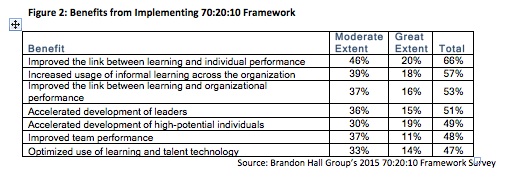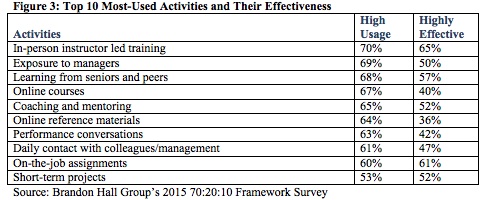
Since its first publication in 1994, organizations have been struggling to live up to the 70:20:10 model for learning. Companies still tend to focus much of their learning efforts on formal learning, which makes up just 10 percent of how people learn. This article will analyze recent Brandon Hall Group research and examine best practices of organizations that have adopted the model.
If you aren’t already familiar with the 70-20-10 research, it is a learning model based on research in the early 1980s done by the Center for Creative Leadership. The various forms of the research were published in the book, “Career Architect Development,” which noted that the most effective learning occurs when about 70 percent of it is experiential, 20 percent is social, and 10 percent is formal.
Key findings from Brandon Hall Group’s recent research on use of the 70:20:10 Learning Framework include:
- More than 60 percent of organizations have adopted the framework in some manner.
- A majority of organizations using the framework have seen significant improvement in the links between learning and both individual and organizational performance.
- The 70:20:10 framework enables organizations to maximize informal learning opportunities.
- Even in a 70:20:10 environment, the classroom is still king, but some companies may not be focusing on the most effective activities.
Approximately 21 percent of companies say they have formally adopted the 70:20:10 framework. This means they have studied the model and integrated its concepts and considerations into their overall learning strategy. Another 41 percent have informally implemented the framework, using the research to inform the way they design and deliver learning. That means that in about 20 years, more than 60 percent of companies have recognized the science behind the model and are at least trying to develop a strategy that takes the way people learn into account.

Even among the companies that have not yet implemented the model, approximately half say they are on track to do so within the next year. That leaves just 20 percent reporting they have no plans to implement the framework at all. Roughly half of companies have been working with the model for one to three years.
The Framework Works
Companies that have adopted the framework report considerable benefits. Prior to using the model, formal training took an average of 43 percent of all learning approaches, the same as experiential training. The remaining 14 percent was informal learning. By adopting the framework, organizations have been able to significantly increase the use of informal learning. Also, a majority of organizations using 70:20:10 have seen significantly improved links between learning and individual and organizational performance.

Two-thirds of companies report that the framework has improved the link between learning and individual performance. If we include those that reported even a small improvement, the number jumps to 95 percent. Although fifth on the list above, 19 percent of companies said that they saw accelerated development of high potentials to a great extent, putting it right behind the individual performance link for greatest extent of impact from the model.
What’s Involved?
By definition, the 70:20:10 model incorporates a blend of multiple learning modalities and activities. The biggest part of this blend is instructor-led training. This is true with or without the framework: The classroom is king and will continue to be. Once we get out of the classroom, we get to see the wide variety of tools companies have put in place as part of their strategy, to what extent they use them, and how effective they find them to be.

This data highlight some of the disconnect between how effective an approach may be and how much it gets used. Instructor-led training leads in both categories, but on-the-job assignments are considered more effective than everything outside of the classroom, but are ninth in terms of usage. Online reference tools are used quite a bit but aren’t really that effective.
There are many reasons why these discrepancies exist. For one, it would be impossible to use all of these activities to a great extent, and on-the-job assignments is a good example. As effective as they are, employees can’t be expected to spend a majority of their time involved in experiential learning. Conversely, online reference materials are easy to produce and maintain, so it makes sense to have them available all the time. Some of the least effective activities used as part of the model include Massive Open Online Courses (MOOCs), contract work, board positions, and attending lectures.
Key Takeaways
Take a Look at Your Blend: Is your organization really delivering blended learning? Or is it mainly classroom with an e-learning click-through now and again? There is a vast array of tools at your disposal, and it is imperative you start finding the ones that make the most sense for your learning outcomes and, most of all, for the learners themselves. The 70:20:10 framework is not a rigid formula. It is a guideline based on the science of how people learn. Be sure to identify your critical success factors and use them to develop the strategy.
It’s Not the End of the Classroom: Even when an organization formally adopts the 70:20:10 framework into its learning strategy, the classroom is still likely to reign supreme. Think of it as a learning solar system, where an ever-increasing array of informal and experiential learning tools orbit around the classroom. The key is not to destroy the classroom, but rather to use it to its greatest potential while leveraging the rest of the methods to enhance, supplement, and complement instructor-led training.
David Wentworth is senior learning analyst for Brandon Hall Group, a human capital management (HCM) research and advisory services firm that provides insights around key performance areas, including Learning and Development, Talent Management, Leadership Development, Talent Acquisition, and HR/Workforce Management.



